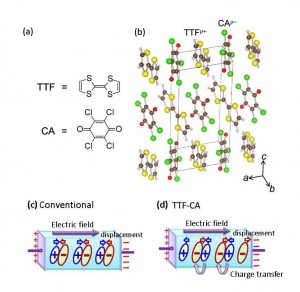Demonstration of novel principle of electric polarization in an organic ferroelectric Electron-transfer mechanism may lead to sophisticated ferroelectrics

A group including researchers from the University of Tokyo has discovered a new phenomenon, “electronic ferroelectricity,” through electric polarization measurements and synchrotron X-ray diffraction experiments. The discovery was made by researcher Kensuke Kobayashi and Professors Reiji Kumai, Youichi Murakami from the Institute of Materials Structure Science at KEK, in collaboration with Sachio Horiuchi and his team at the National Institute of Advanced Industrial Science and Technology, Fumitaka Kagawa (project lecturer at the University of Tokyo Department of Applied Physics), and Yoshinori Tokura (professor at the University of Tokyo Department of Applied Physics and group director of Riken). Electronic ferroelectricity is a mechanism by which the magnitude and direction of electric polarization in organic ferroelectrics are determined by the dynamic motion of elements between molecules. Systems exhibiting this type of ferroelectricity show polarization response to electric fields exceeding 20 times that in the classical displacement model, where static charges shift with the displacement of ions, resulting in spontaneous polarization; therefore, the discovery of the aforementioned phenomenon is expected to drive further improvement of performance in ferroelectrics.
Paper
K. Kobayashi, S. Horiuchi, R. Kumai, F. Kagawa, Y. Murakami, and Y. Tokura,
“Electronic Ferroelectricity in a Molecular Crystal with Large Polarization Directing Antiparallel to Ionic Displacement”,
Physical Review Letters 108 (2012): 237601, doi: 10.1103/PhysRevLett.108.237601.
Article link
Links
Graduate School of Engineering








